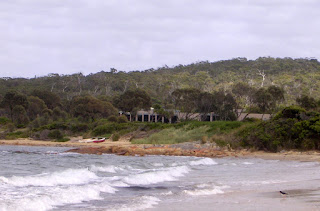After a pleasant early morning walk along the beach, we started on the long trip to Cradle Mountain, taking us from the east coast to a mountainous area in the central western part of the island. Our route went north up the east coast for some distance, with mountains to the west and the Tasman Sea to the east—occasionally affording views of surf beaches, with huge waves rolling in.
We stopped at a roadside picnic table to eat our lunch in Mole Creek, a small locality—not really a ‘town,’ as the map indicated; it was not much more than one road through the middle. But it struck us as very similar to many other places we had driven through, with a grocery store—IGA, which called itself a supermarket; a few typical older style Australian houses with a corrugated metal roofs; a small church; and the Memorial Hall.
The climb to Cradle Mountain is unavoidably long and steep, and we unfortunately chose the “tourist route”, which meant a very narrow and tortuous road, steep gradients up and down, without guard rails, only to find that the final stretch was closed, presumably due to flood damage. We had to retrace our steps to rejoin the main road via a place called, oddly, Paradise. We stopped in Sheffield on the way, which had unexpected rewards.
Sheffield runs a Mural Painting Competition every year, and they claim that artists from all over the world come to compete: the winner’s mural remains, and the others get painted over the following year. The whole town is plastered with them.
We finally made it to our destination, which was pretentiously named The Cradle Mountain Chateau. It was an unimaginative barn-like building--wood with corrugated metal roof--and each room had a silly little postage stamp balcony with an ashtray attached to the railings to cater for smokers.
The dividing walls were thin; we could hear conversations, flushing/shower taking, and television in the adjacent room. There were two expensive restaurants—the cheaper one serving an evening buffet at $35 a person: we did not bother to check the prices of the other one. Internet connection did not work—but if it did, the cost was $2 for ten minutes. The hot tub had no water, and the “Activities Centre” was inactive.
In front of the hotel there was something called The Rainforest Walk, which consisted of a narrow boardwalk that wandered around in a circle of about three hundred yards. At a number of points were small notices, on each of which were single words —like “Reproduction,” “Shhhsh,” “Travellers.” One that did have a meaning was “Water,” which was stuck in the bank of a stream, and was presumably there to inform walkers who did not know what that flowing liquid was.
The saving grace of the hotel was an adjacent nature photography gallery—free to hotel residents. A series of light and airy gallery rooms—excellent architectural design--show-cased an exhibition of nature photography by a number of photographers of extraordinary skill. The pictures were very, very beautiful, and rarely have we ever seen such a stunning exhibition of photography. The gallery was called The Wilderness Gallery (www.wildernessgallery.com.au), and it claims to be the largest privately-owned photography gallery in the world--easy to claim: less easy to prove: but the pictures were incredible and engaged us for an hour while the rain poured down.












No comments:
Post a Comment